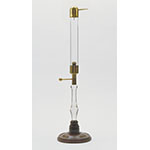This device was used to simulate the aurora borealis phenomenon.
The glass tube is supported on a glass pillar, with a turned mahogany base, weighted by means of a lead ring to prevent the instrument from toppling over. A brass spike projects at right angles from the upper brass collar. A ball electrode is joined to the lower brass collar. Inside the tube are two other electrodes: the upper one ends in a point, the lower one in a ball.
The tube is partially evacuated by means of an air pump. The glass is then rubbed with a cloth or the electrodes are touched with the conductor of an electrical machine. The electrification causes the inside of the tube to glow with a light closely resembling an aurora borealis.
William Henley used a comparable instrument to demonstrate the glow produced by positive or negative discharges. He claimed this as proving Benjamin Franklin's theory of a single electric fluid. Filippo Lucci depicted a very similar device in the Stanzino of the Matematiche of the Uffizi in 1780—clear evidence of the popularity of such demonstrations in the late eighteenth century. Provenance: Lorraine collections.










